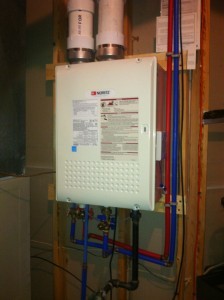One of the most important details in installing your tankless water heater is how you vent your tankless water heater. Proper venting of a tankless water heater can ensure efficient operating and save the lifespan of your unit.

Choosing the tankless route for your family’s water heating needs surely comes with all sorts of benefits--like cutting down on resources, saving your monthly bill and eliminating excess waste--but it also comes with its own unique maintenance and management. While known for saving homeowners money because they’re not constantly running and reheating mass amounts of water, tankless models save energy because they only fire up when needed.
Tankless water heaters thus tend to outlast outdated and oversized models because they are compact, convenient and efficient. But tankless water heaters that are gas fired can also have their own issues if not installed properly, like failing to live up to their intended lifespan because of poor venting. Venting a tankless water heater according to the manufacturer’s instructions is essential to the installation process for the water heater to function at length and effectively, and most importantly, to avoid any chance of danger and the risk of carbon monoxide poisoning.
Tankless water heaters allow for either horizontal venting (out a side wall) or up through the roof. Because tankless water heaters require PVC or special stainless steel piping as the vent material (which is much more expensive than copper, PEX or CPVC), a short venting run is better for both the heater itself, as well as your savings, so many homeowners choose to move the location of their heater closer to an outside wall and run water lines to it instead. The Category III AL29-4C stainless steel is necessary because the combustion efficiency of the heater is likely to create a highly acidic condensate that destroys your standard vent material in just short amounts of time. The special stainless steel venting material also helps to withstand the positive pressure created by the system.
Sticking to the guidelines set out in the manufacturer's instructions will ensure you get the most out of your tankless water heater, saving you time, energy and money with every use. Venting your tankless water heater properly the first time around works to eliminate the possibility of inefficiency and risk, when dealing with something as serious as gas and carbon monoxide. Extra attention spent in the proper installation of your venting saves you the worry later, knowing your tankless water heater is draining condensate and expelling gasses safely.